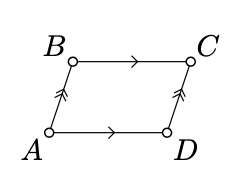7.5: Parallelograms
- Page ID
- 23623
\( \newcommand{\vecs}[1]{\overset { \scriptstyle \rightharpoonup} {\mathbf{#1}} } \)
\( \newcommand{\vecd}[1]{\overset{-\!-\!\rightharpoonup}{\vphantom{a}\smash {#1}}} \)
\( \newcommand{\dsum}{\displaystyle\sum\limits} \)
\( \newcommand{\dint}{\displaystyle\int\limits} \)
\( \newcommand{\dlim}{\displaystyle\lim\limits} \)
\( \newcommand{\id}{\mathrm{id}}\) \( \newcommand{\Span}{\mathrm{span}}\)
( \newcommand{\kernel}{\mathrm{null}\,}\) \( \newcommand{\range}{\mathrm{range}\,}\)
\( \newcommand{\RealPart}{\mathrm{Re}}\) \( \newcommand{\ImaginaryPart}{\mathrm{Im}}\)
\( \newcommand{\Argument}{\mathrm{Arg}}\) \( \newcommand{\norm}[1]{\| #1 \|}\)
\( \newcommand{\inner}[2]{\langle #1, #2 \rangle}\)
\( \newcommand{\Span}{\mathrm{span}}\)
\( \newcommand{\id}{\mathrm{id}}\)
\( \newcommand{\Span}{\mathrm{span}}\)
\( \newcommand{\kernel}{\mathrm{null}\,}\)
\( \newcommand{\range}{\mathrm{range}\,}\)
\( \newcommand{\RealPart}{\mathrm{Re}}\)
\( \newcommand{\ImaginaryPart}{\mathrm{Im}}\)
\( \newcommand{\Argument}{\mathrm{Arg}}\)
\( \newcommand{\norm}[1]{\| #1 \|}\)
\( \newcommand{\inner}[2]{\langle #1, #2 \rangle}\)
\( \newcommand{\Span}{\mathrm{span}}\) \( \newcommand{\AA}{\unicode[.8,0]{x212B}}\)
\( \newcommand{\vectorA}[1]{\vec{#1}} % arrow\)
\( \newcommand{\vectorAt}[1]{\vec{\text{#1}}} % arrow\)
\( \newcommand{\vectorB}[1]{\overset { \scriptstyle \rightharpoonup} {\mathbf{#1}} } \)
\( \newcommand{\vectorC}[1]{\textbf{#1}} \)
\( \newcommand{\vectorD}[1]{\overrightarrow{#1}} \)
\( \newcommand{\vectorDt}[1]{\overrightarrow{\text{#1}}} \)
\( \newcommand{\vectE}[1]{\overset{-\!-\!\rightharpoonup}{\vphantom{a}\smash{\mathbf {#1}}}} \)
\( \newcommand{\vecs}[1]{\overset { \scriptstyle \rightharpoonup} {\mathbf{#1}} } \)
\( \newcommand{\vecd}[1]{\overset{-\!-\!\rightharpoonup}{\vphantom{a}\smash {#1}}} \)
\(\newcommand{\avec}{\mathbf a}\) \(\newcommand{\bvec}{\mathbf b}\) \(\newcommand{\cvec}{\mathbf c}\) \(\newcommand{\dvec}{\mathbf d}\) \(\newcommand{\dtil}{\widetilde{\mathbf d}}\) \(\newcommand{\evec}{\mathbf e}\) \(\newcommand{\fvec}{\mathbf f}\) \(\newcommand{\nvec}{\mathbf n}\) \(\newcommand{\pvec}{\mathbf p}\) \(\newcommand{\qvec}{\mathbf q}\) \(\newcommand{\svec}{\mathbf s}\) \(\newcommand{\tvec}{\mathbf t}\) \(\newcommand{\uvec}{\mathbf u}\) \(\newcommand{\vvec}{\mathbf v}\) \(\newcommand{\wvec}{\mathbf w}\) \(\newcommand{\xvec}{\mathbf x}\) \(\newcommand{\yvec}{\mathbf y}\) \(\newcommand{\zvec}{\mathbf z}\) \(\newcommand{\rvec}{\mathbf r}\) \(\newcommand{\mvec}{\mathbf m}\) \(\newcommand{\zerovec}{\mathbf 0}\) \(\newcommand{\onevec}{\mathbf 1}\) \(\newcommand{\real}{\mathbb R}\) \(\newcommand{\twovec}[2]{\left[\begin{array}{r}#1 \\ #2 \end{array}\right]}\) \(\newcommand{\ctwovec}[2]{\left[\begin{array}{c}#1 \\ #2 \end{array}\right]}\) \(\newcommand{\threevec}[3]{\left[\begin{array}{r}#1 \\ #2 \\ #3 \end{array}\right]}\) \(\newcommand{\cthreevec}[3]{\left[\begin{array}{c}#1 \\ #2 \\ #3 \end{array}\right]}\) \(\newcommand{\fourvec}[4]{\left[\begin{array}{r}#1 \\ #2 \\ #3 \\ #4 \end{array}\right]}\) \(\newcommand{\cfourvec}[4]{\left[\begin{array}{c}#1 \\ #2 \\ #3 \\ #4 \end{array}\right]}\) \(\newcommand{\fivevec}[5]{\left[\begin{array}{r}#1 \\ #2 \\ #3 \\ #4 \\ #5 \\ \end{array}\right]}\) \(\newcommand{\cfivevec}[5]{\left[\begin{array}{c}#1 \\ #2 \\ #3 \\ #4 \\ #5 \\ \end{array}\right]}\) \(\newcommand{\mattwo}[4]{\left[\begin{array}{rr}#1 \amp #2 \\ #3 \amp #4 \\ \end{array}\right]}\) \(\newcommand{\laspan}[1]{\text{Span}\{#1\}}\) \(\newcommand{\bcal}{\cal B}\) \(\newcommand{\ccal}{\cal C}\) \(\newcommand{\scal}{\cal S}\) \(\newcommand{\wcal}{\cal W}\) \(\newcommand{\ecal}{\cal E}\) \(\newcommand{\coords}[2]{\left\{#1\right\}_{#2}}\) \(\newcommand{\gray}[1]{\color{gray}{#1}}\) \(\newcommand{\lgray}[1]{\color{lightgray}{#1}}\) \(\newcommand{\rank}{\operatorname{rank}}\) \(\newcommand{\row}{\text{Row}}\) \(\newcommand{\col}{\text{Col}}\) \(\renewcommand{\row}{\text{Row}}\) \(\newcommand{\nul}{\text{Nul}}\) \(\newcommand{\var}{\text{Var}}\) \(\newcommand{\corr}{\text{corr}}\) \(\newcommand{\len}[1]{\left|#1\right|}\) \(\newcommand{\bbar}{\overline{\bvec}}\) \(\newcommand{\bhat}{\widehat{\bvec}}\) \(\newcommand{\bperp}{\bvec^\perp}\) \(\newcommand{\xhat}{\widehat{\xvec}}\) \(\newcommand{\vhat}{\widehat{\vvec}}\) \(\newcommand{\uhat}{\widehat{\uvec}}\) \(\newcommand{\what}{\widehat{\wvec}}\) \(\newcommand{\Sighat}{\widehat{\Sigma}}\) \(\newcommand{\lt}{<}\) \(\newcommand{\gt}{>}\) \(\newcommand{\amp}{&}\) \(\definecolor{fillinmathshade}{gray}{0.9}\)
A quadrangle \(ABCD\) in the Euclidean plane is called nondegenerate if no three points from \(A, B, C, D\) lie on one line.
A nondegenerate quadrangle is called a parallelogram if its opposite sides are parallel.
Any parallelogram is centrally symmetric with respect to a midpoint of one of its diagolals.
In particular, if \(\square ABCD\) is a parallelogram, then
(a) its diagonals \([AC]\) and \([BD]\) intersect each other at their midpoints;
(b) \(\measuredangle ABC = \measuredangle CDA\);
(c) \(AB = CD\).
- Proof
-

Let \(\square ABCD\) be a parallelogram. Denote by \(M\) the midpoint of \([AC]\).
Since \((AB)\parallel (CD)\), Theorem 7.2.1 implies that \((CD)\) is a reflection of \((AB)\) across \(M\). The same way \((BC)\) is a reflection of \((DA)\) across \(M\). Since \(\square ABCD\) is nondegenerate, it follows that \(D\) is a reflection of \(B\) across \(M\); in other words, \(M\) is the midpoint of \([BD]\).
The remaining statements follow since reflection across \(M\) is a direct motion of the plane (see Proposition 7.2.1).
Assume \(ABCD\) is a quadrangle such that
\(AB = CD = BC = DA.\)
Such that \(ABCD\) is a parallelogram.
- Hint
-
Since \(\triangle ABC\) is isosceles, \(\measuredangle CAB = \measuredangle BCA\).
By SSS, \(\triangle ABC \cong \triangle CDA\). Therefore, \(\pm \measuredangle DCA = \measuredangle BCA = \measuredangle CAB\).
Since \(D \ne C\), we get "-" in the last formula. Use the transversal property (Theorem 7.3.1) to show that \((AB) \parallel (CD)\). Repeat the argument to show that \((AD) \parallel (BC)\).
A quadrangle as in the exercise above is called a rhombus.
A quadrangle ABCD is called a rectangle if the angles ABC, BCD, CDA, and DAB are right. Note that according to the transversal property (Theorem 7.3.1), any rectangle is a parallelogram.
A rectangle with equal sides is called a square.
Show that the parallelogram \(ABCD\) is a rectangle if and only if \(AC = BD\).
- Hint
-
By Lemma \(\PageIndex{1}\) and SSS, \(AC = BD\) if and only if \(\angle ABC = \pm \measuredangle BCD\). By the transversal property (Theorem 7.3.1), \(\measuredangle ABC + \measuredangle BCD \equiv \pi\).
Therefore, \(AC = BD\) if and only if \(\measuredangle ABC = \measuredangle BCD = \pm \dfrac{\pi}{2}\).
Show that the parallelogram \(ABCD\) is a rhombus if and only if \((AC) \perp (BD)\).
- Hint
-
Fix a parallelogram \(ABCD\). By Lemma \(\PageIndex{1}\), its diagonals \([AC]\) and \([BD]\) have a common midpoint; denote it by \(M\).
Use SSS and Lemma \(\PageIndex{1}\) to show that
\(AB = CD \Leftrightarrow \triangle AMB \cong \triangle AMD \Leftrightarrow \measuredangle AMB = \pm \dfrac{\pi}{2}.\)
Assume \(\ell \parallel m\), and \(X, Y \in m\). Let \(X'\) and \(Y'\) denote the foot points of \(X\) and \(Y\) on \(\ell\). Note that \(\square XYY'X'\) is a rectangle. By Lemma \(\PageIndex{1}\), \(XX' = YY'\). That is, any point on \(m\) lies on the same distance from \(\ell\). This distance is called the distance between \(\ell\) and \(m\).


